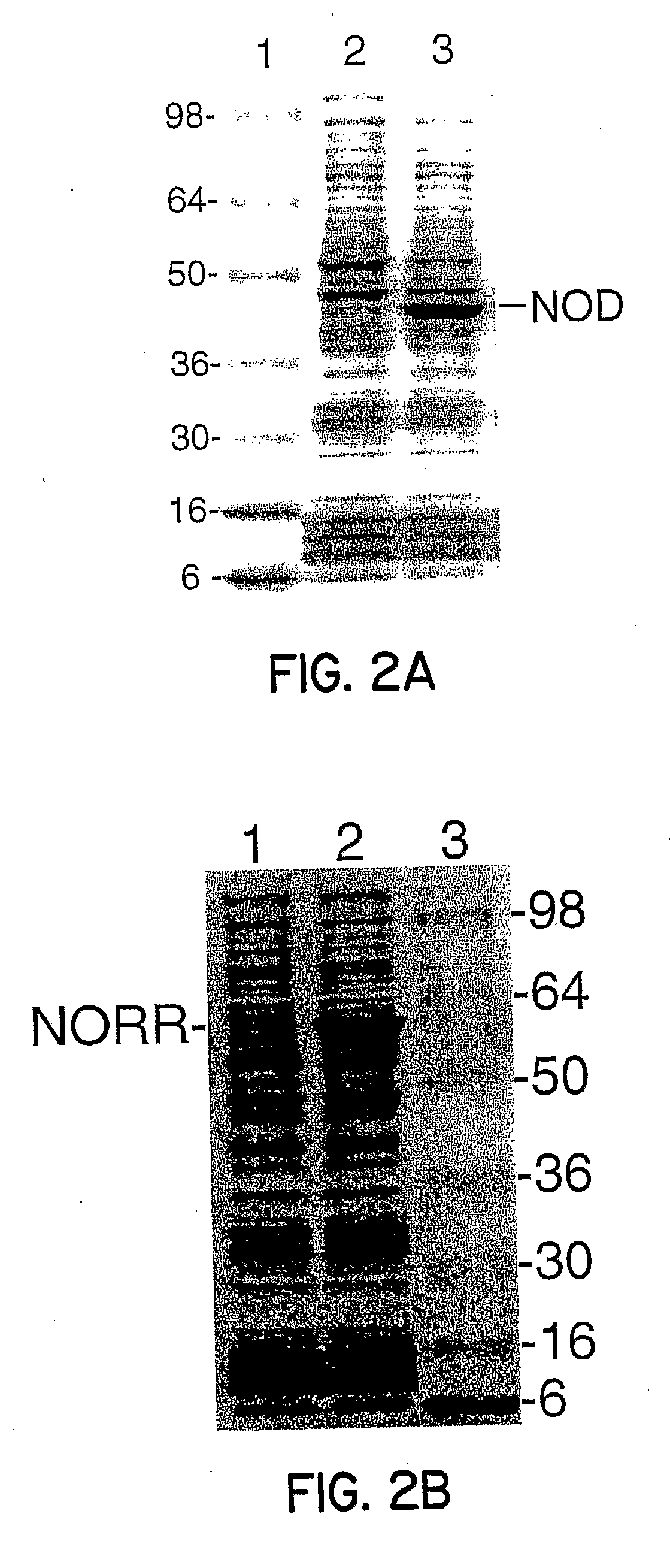Vector to Induce Expression of Recombinant Proteins under Anoxic or Microaerobic Conditions
a technology of recombinant proteins and recombinant proteins, which is applied in the field of recombinant protein expression vectors, can solve the problems of poor cell growth, reduced protein yield, difficult and expensive maintenance of proper aeration once a culture is dense, etc., and achieves simple and less expensive, constant aeration
- Summary
- Abstract
- Description
- Claims
- Application Information
AI Technical Summary
Benefits of technology
Problems solved by technology
Method used
Image
Examples
example 1
Protein Expression Using the pANX Vector
[0052]The pANX vector, in this embodiment, is a derivative of pUC19 in which the NOD upstream region (812 bp Pvull to Sma1 fragment) was inserted in the polylinker at the Sma1 site. The Nde1 site of pUC19 was destroyed by filling in with Klenow fragment and religating. A start methionine was encoded in the Nde1 site in the NOD promoter. The NOD promoter can be induced to high level of expression with 10 mM nitrate in low aeration or anaerobic cultures.
[0053]Cultures of E. coli AB1157 with various protein coding regions subcloned in pANX were grown aerobically to OD550 0.6 in LB (Luria Broth) with 50 μg / ml ampicillin. The cultures were used to inoculate 900 ml of modified Terrific Broth to an optical density of 0.01 at 550 nm. Beef liver catalase (Roche) 260 U / ml final was added for protection of proteins sensitive to H2O2 damage. The cultures were grown overnight at 37° C. with slow shaking (˜100 revolutions per minute) in a rotary shaker-wate...
example 2
Induction of NOD
[0056]Referring to FIG. 2A, the coding region for NOD was subcloned in pANX, cultures were grown, and protein expression induced as described in Example 1. Induction and purification of NOD led to high yields, such as 50-200 mg of 90% pure protein from a 12-liter batch. NOD produced a low level of superoxide from bound oxygen and certain site-directed mutations in the NOD active site increased constitutive superoxide radical and hydrogen peroxide production to toxic levels. These proteins can only be efficiently produced under conditions of low aeration where superoxide radical and hydrogen peroxide production is limited.
example 3
Induction of NorR
[0057]Referring to FIG. 2B, the coding region for NorR was subcloned in pANX, cultures were grown, and protein expression induced as described in Example 1. In the present invention, pANX was used to express the full-length NorR transcription factor in high yield, such as 50 mg of 90% pure protein from an 8-liter batch and in a soluble form (See FIG. 2B).
PUM
| Property | Measurement | Unit |
|---|---|---|
| pH | aaaaa | aaaaa |
| optical density | aaaaa | aaaaa |
| acid | aaaaa | aaaaa |
Abstract
Description
Claims
Application Information
 Login to View More
Login to View More - R&D
- Intellectual Property
- Life Sciences
- Materials
- Tech Scout
- Unparalleled Data Quality
- Higher Quality Content
- 60% Fewer Hallucinations
Browse by: Latest US Patents, China's latest patents, Technical Efficacy Thesaurus, Application Domain, Technology Topic, Popular Technical Reports.
© 2025 PatSnap. All rights reserved.Legal|Privacy policy|Modern Slavery Act Transparency Statement|Sitemap|About US| Contact US: help@patsnap.com



